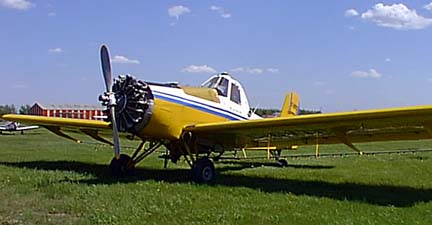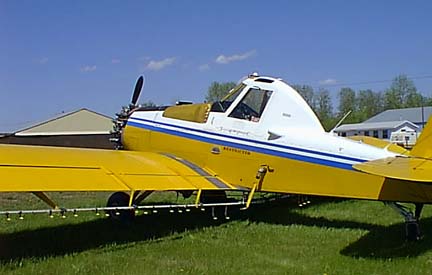| Melfort Spray Pilot Dies After Crash Thursday |
| FTLComm - Star City July 1, 2000 Thursday afternoon  temperatures soared and humidity rose right around noon.
The spray plane operating off the Tisdale airport was parked after a morning of
application but it was decided that conditions were just too dangerous for fence
hopping. temperatures soared and humidity rose right around noon.
The spray plane operating off the Tisdale airport was parked after a morning of
application but it was decided that conditions were just too dangerous for fence
hopping.Unfortunately a forty-two year old pilot from Melfort flying an aircraft like the one in these pictures was working some fields just South and West of Star City. I saw him at about 1:45 and the 650 horse power Thrush was using up a lot of air to make the turns at each end of the field. |
Hot moist air is thinner and less dense then cool dry air and right along the surface,
where spraying takes place, the air is the hotest and the dampest. An aircraft that
might normally stall at fifty-five or sixty knots will start to no longer fly at
seventy-five as lift is simply not available from the hot rising air. When a spray
plane executes its turn at the end of the field to begin its next run the pilot jigs
right, does a climbing left turn to re-align himself for the next pass. In that
turn with 350 gallons of chemical aboard the aircraft is extra-ordinarily vunerable
to stalling. Early assessment of the crash appears to indicate that this is what happened. As the pilot began his turn and at the top of the turn the aircraft stalled and fell nose first into the field. The force of the impact compressed the airframe so that it is now an arms length from the propeller to the back of the pilot's seat. These machines are designed to handle a moving sliding crash so that the cockpit has a cage that can maintain integrity and protect the pilot so that most accidents with result in minor injury, not death. However, for reasons yet unknown, it was two hours after the plane departed the Melfort airport that people there realised that something was wrong and a ground search was begun. We have heard no explanation as to why the aircraft's ELT (Emergency Locator Transmitter) standard on all aircraft did not go off as this would have alerted all aircraft and the satellites designed to detect air crashes. Meanwhile, a Star City farmer out checking his fields came upon the wreakage and called for an ambulance. The pilot with about eight-hundred flying hours who had only been spraying for a little more than a year, died in the ambulance on the way to hospital. |
|
The demand for spray work has really increased in this past week as farmers need
to respond to fungal development in malting barley crops. The Tisdale spraying operation
plans to do a thousand acres today and tomorrow. At the time of writing this spraying
operations are grounded because of low ceilings. Timothy W. Shire |